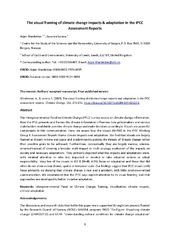The visual framing of climate change impacts and adaptation in the IPCC assessment reports
Journal article, Peer reviewed
Accepted version
Permanent lenke
https://hdl.handle.net/1956/21907Utgivelsesdato
2019Metadata
Vis full innførselSamlinger
Originalversjon
https://doi.org/10.1007/s10584-019-02522-6Sammendrag
The Intergovernmental Panel on Climate Change (IPCC) is a key source on climate change information. How the IPCC presents and frames this climate information influences how policymakers and various stakeholders worldwide perceive climate change and make decisions accordingly. Visuals are powerful components in this communication. Here, we assess how the visuals (N = 702) in the IPCC Working Group II Assessment Reports frame climate impacts and adaptation. We find that visuals are largely framed as distant in time and space and predominantly portray the threats of climate change rather than possible goals to be achieved. Furthermore, conceptually, they are largely narrow, science-oriented instead of showing a broader multi-impact or multi-strategy evaluation of the impacts on society and necessary adaptations. They primarily depicted what the impacts and adaptations were, with minimal attention to who was impacted or needed to take adaption actions or adopt responsibility. Very few of the visuals in WG II (N = 48, 6.5%) focus on adaptation and those that did often do not show a clear theme, spatial or temporal scale. Our findings suggest that IPCC visuals (still) focus primarily on showing that climate change is real and a problem, with little solution-oriented communication. We recommend that the IPCC pays explicit attention to its visual framing and that approaches are developed to better visualise adaptation.
